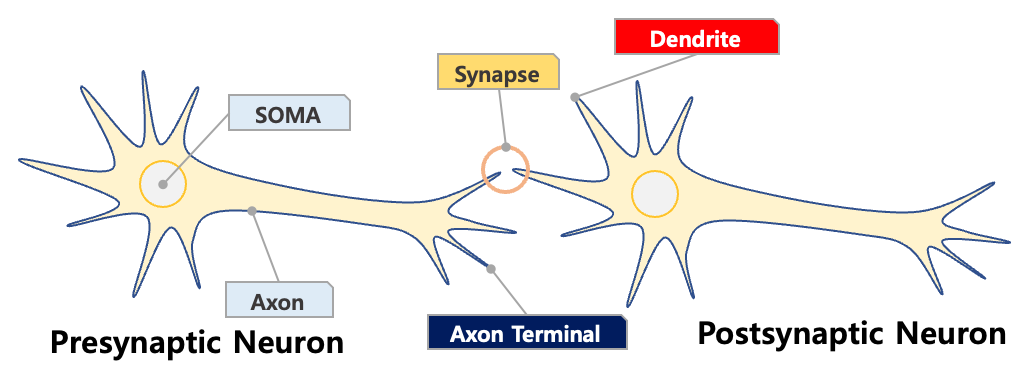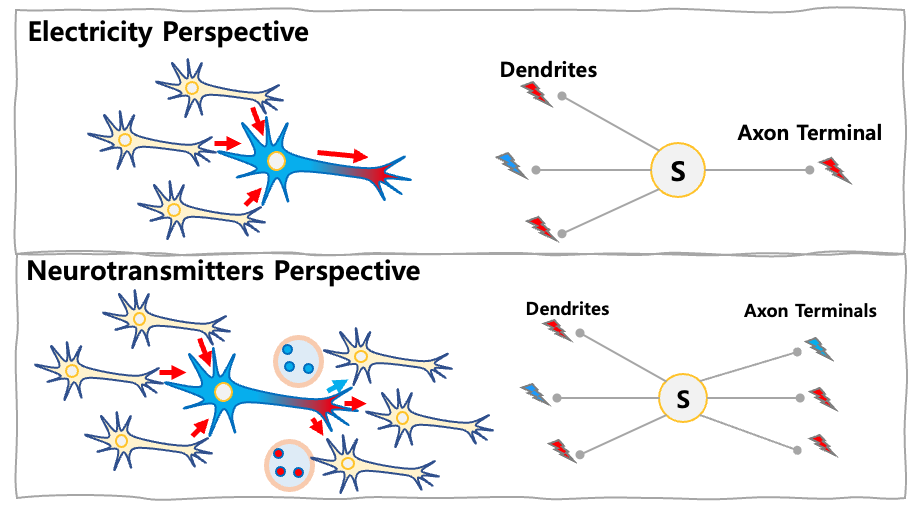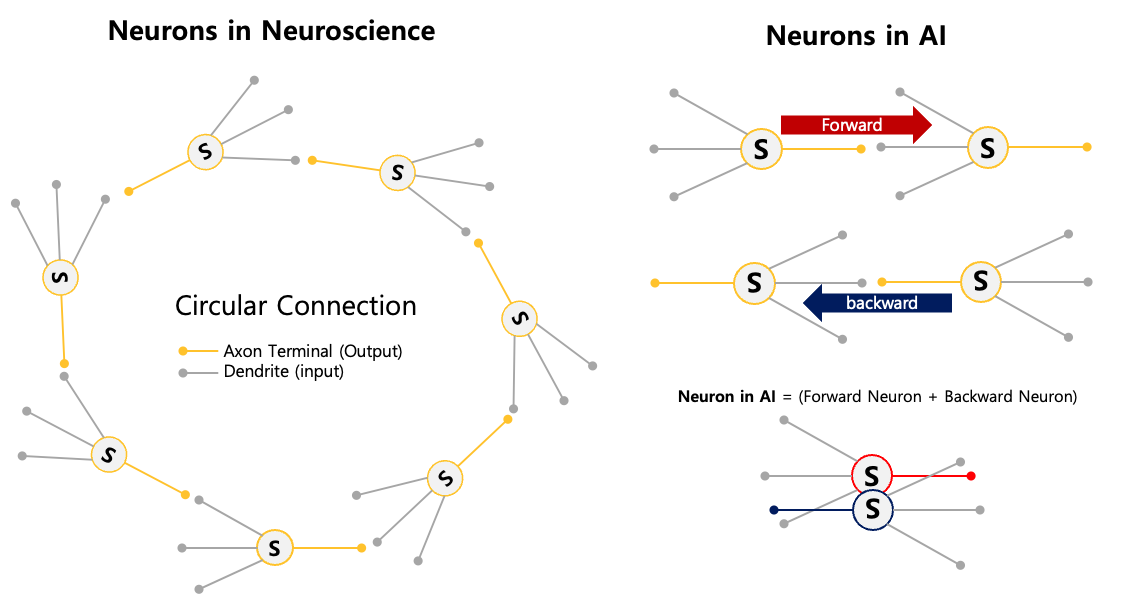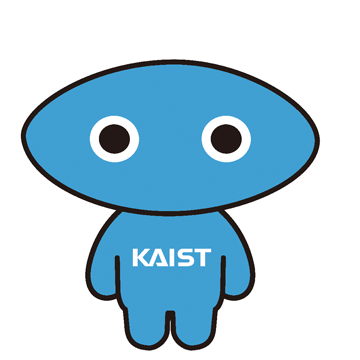Neuron in Neuroscience and Deep Learning
How can we compare neurons in neuroscience and deep learning?
[📚 Neuron Series 1]
Introduction
There are several attempts to understand human in the fields of biology, neuroscience, ethology, and philosophy. Especially, neuroscience interprets human with neurons in a brain. Neurons in a brain process massive information and the intelligence increases as the number of neurons increases. However, understanding the general role of a single neuron is hardly discovered as we can not test the neuron separately excluding other neurons. However, unlike the neurons in neuroscience, neurons in deep learning could be tested easily as we can debug the network. Recent studies have shown the role of individual neurons in both vision and NLP domains and we can understand the interaction between neurons well. If the neurons in our brain compute and process the signals with the neurons in deep learning, we can further understand neurons in both field. To do this, we should know how similar neurons in neuroscience and deep learning are.
The reason why I wrote this post, even though I studied deep learning, is that understanding the neurons in neuroscience can further helps to reveal the mechanisms of neurons in deep learning. To components are similar to each other, but have distinct difference such as learning processes. We study the question How much neurons are similar in both fields? Before answering this question we should answer this question. What is neurons in deep learning?
Neuroscience
Human body has cell and there are cells called neuron whose role is the transmission of signals. Neurons communicate each other by chemical materials called synapse which is the connection part between two neurons. In human brain, there are 860B number of neurons and a single neuron has 7,000 synapses. Therefore, human brain has 6 trillion synapses.
\[\begin{gather} \text{Number of Neurons} \times \text{Number of Synapses per a neuron} \approx \text{Total number of synapses} \\ \Rightarrow 860 \text{B} \times 7,000 \approx 6 \text{trillion} \end{gather}\]The number of synapses is the number of connections and the neurons has information in it. When a single neuron is fired, we can consider the successively fired neurons like a chain. Consider the following example.
- Eyes get light signals (Dog image 🦮)
- neurons in eyes are fired and signal is transmitted to the neurons in the brain (Neurons related to vision 👀)
- Several neurons in a brain are affected by the vision neurons
- Emergence of vocabulary “dog” (Dog Neuron 🐶)
- Emergence of vocabulary “cat” by “dog” (Cat Neuron 😸)
- Prediction of the dog movement (Future Prediction Neuron ⌛️)
- Emergence of traumas related to a dog (Long-term Memory Neuron 🐾)
- Trauma makes me feel bad (Emotion Neuron 😢)
Note that even though we only observed the dog image, other neurons related to the dog are fired. Understanding the circuits of neurons are like finding such consequent events of neurons.
Neuron
These videos can help your understanding of neurons
Basic Structure
Neurons communicate with each other with chemical materials such as Na+ and Cl-, and process the signal in terms of electricity. To understand this communication process, lets see what components a neuron has.

-
dendrites: Obtains chemical materials from other neurons (receiver) -
SOMA(Nuclear) : The nuclear of a neuron -
Axon: connectsdendritesandaxon terminaland transfers the electrical signal. -
Axon terminals: transmits chemical materials to other neurons (publisher)
Communication
A neuron is normally a negative state (-70mv) and if a dendrite receives negative ion, the state is still negative. On the other hand, if dendrite receives positive ions such as $Na^{+}$, the dendrite part becomes positive state. Then, the electricity flows from dendrite to axon terminal in a neuron to make Neutral Charge Equilibrium state. The pipe for the transmission is called axon and the leaf part is axon terminal. When the axon terminal becomes positive state, neurotransmitters spread.

In summary, a successive propagation of chemical makes the communication.
Synapse
Synapse is the connected parts of dendrite and axon terminal. Synapse is the location where the communication between two neurons occur, and we call the sender and receiver as follows:
N: Neuron, [*] Other Neurons
-
(Left) Presynaptic Neuron : a neuron transmits signal with
axon terminal$(N \rightarrow [*])$ -
(Right) Postynaptic Neuron : a neuron receives with
dendrite\(([*] \rightarrow N)\)

Aggregation of Received signal
The electrical signal flows in a neuron is either (+) or (-), but the received chemicals at dendrites are combined. Therefore, the aggregated (summed) electrical signal is transferred along Axon. In other words, the ions $T_1, T_2, \cdots$ at dendrites are summed and generate the electrical signal.
\(\text{Electrical Signal} = T_1 + T_2 + T_3 + T_4 + \cdots\)

Recall that there is only one electrical signal, but the several axon terminals transmit different kinds of neurotransmitters.
Neurotransmitters are categorized by whether the chemical further excites the connected neurons. The excitatory neuron spreads positive ions, while the inhibitory neuron spreads negative ions. See Thread: Circuits
Excitatory and Inhibitory Neurotransmitters
- 🔥 Excitatory Neurotransmitters
- Na+
- Acetylcholine
- Noradrenaline
- Glutamate
- ❄️ Inhibitory Neurotransmitters
- Glycine
- GABA (gamma-aminobutyric acid)
- Cl-

Deep Learning
Neuron & Synapse
In the neuroscience section, we introduced the electrical signal made by the multiple chemical signals from dendrites. This operation is same with the dot product which results in a single scalar.

In linear layer, we can interpret each row as a neuron
🚀 Neuron in deep-learning motivated by the neuroscience.**
Neuron : collection of weights which outputs a single scalar. Synapse : each weight in the neuron
- Neuron in neuroscience
- (In) the amount of $K$ chemicals: $a_1, a_2, a_3, \cdots, a_k $
- (Weight) K dendrites: $w_1, w_2, w_3, \cdots, w_k $ (positive or negative)
- (Out) How much activation occurs : $\sum_k w_k \cdot a_k$
- Neuron in deep learning
- (In) Neuron Input : $a_1, a_2, a_3, \cdots, a_k $
- (Weight) Neuron Interpretation : $w_1, w_2, w_3, \cdots, w_k $
- (Out) Neuron Output : $\sum_k w_k \cdot a_k$
In the linear layer, we have weights and biases, $W\in \mathbb{R}^{N\times K}$ and $\mathbf{b}\in \mathbb{R}^{N}$. When we interpret this (1) there are N neurons, (2) each neuron accumulate $K$ signals, and (3) output is linear combined. As all $N$ neurons output a single scalar, the dimension of output is $N$.
- ⭐️ Number of Neurons : $N$ (Dimension of Output)
- ⭐️ Number of Synapses : $N\times K$ (Number of Weights)
Comparison
In the previous section, we found that the dot-product could be interpreted as the computation of a neuroscience neuron. In this section, we compare how communications of two neurons are similar. In deep learning, we consider two message passing paths, forward and backward. However, the neurons in neuroscience only have forward pass to communicate with each other. In addition, the learning paradigm is different that the deep learning neuron learns from the back-propagation of signals, which is not true in neuroscience!
Forward
The figure below shows the major difference in communication. Note that the neurons in neuroscience can form a circular message passing as they are located in the 3D physical system, while the deep learning has only a single forward pass and each neuron process information only one time
In addition, neurons in neuroscience communicate in asynchronous manner, but the computation of neurons in deep learning is synchronous for every layer. Therefore, humans are more stochastic than neurons in deep learning.

Backward
The backward is a natural way of training a deep neural network. The weights in neurons are updated to minimize an objective and back-propagation signal passes in backward. Unlike this, neurons in neuroscience can receive and send information with only two fixed components, dendrites and axon terminals. Therefore, we can not think the neurons in neuroscience use back-propagation to learn. Recent work of Geoffrey Hinton [scholar] is inspired from this observation, and he proposed forward-forward algorithm
Type of Information
The most significant unfairness of deep learning compared to humans is the difference in input. Human eyes receive information as input every moment, and about 200 images are received in high resolution per second. But the deep learning models take an input of the level of an image. Although recent models are designed to take more inputs in order to approximate the amount of information a human receives, deep learning still has the disadvantage of reacting only when input is given.
In addition, unlike humans, deep learnings only work when an input is given: What can deep learning do if there is no input?
Absence of State
In humans, neurons can respond and process information without being given input (e.g., you can recall a picture in your mind and draw conclusions or create new ideas from that picture). This process is considered to retrieve information which is stored in the brain’s long-term memory, but the deep learning parameters are configured to perform operations on given inputs and there is no memory.
State of Creature
Another difference is the type of input. While humans receive information through sensory organs, deep learning models have a fixed input space, and visual, linguistic, or audio information comes in through the input layer. Therefore, the information processed by deep learning is only the input and the output calculated by the internal neurons. However, for humans, there is additional information in addition to the information received as input. It is the state of the body or cognition.
State of body
Do deep learning models change calculation results just because they are tired? No.
In humans, even given the same input, the result can be changed by current hormonal conditions. For example, If you feel sad, you can have different interpretations of the same picture. This suggests that the processing of neurons can be different depending on the body’s states.
State of cognition
Does deep learning keep thinking about information it has seen before? No.
Cognitive contrast is a principle in which the next information is distorted and interpreted by the previously seen information. For example, a tiger next to an elephant is perceived as small because the elephant is large. However we cannot be sure that deep learning neurons analyze things based on this principle of cognitive contrast. They are more likely to interpret simply depending on the information currently available.
